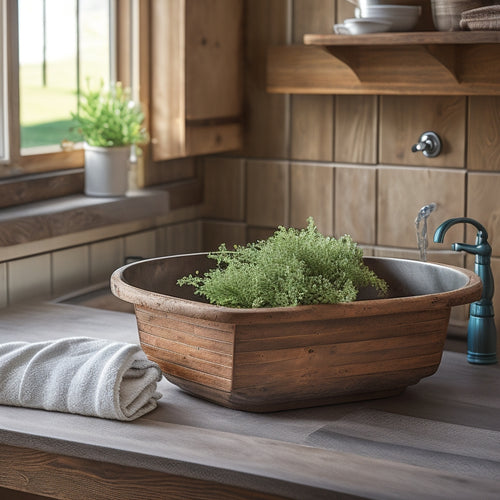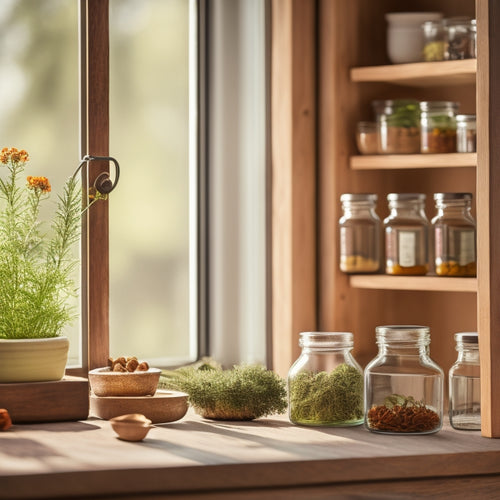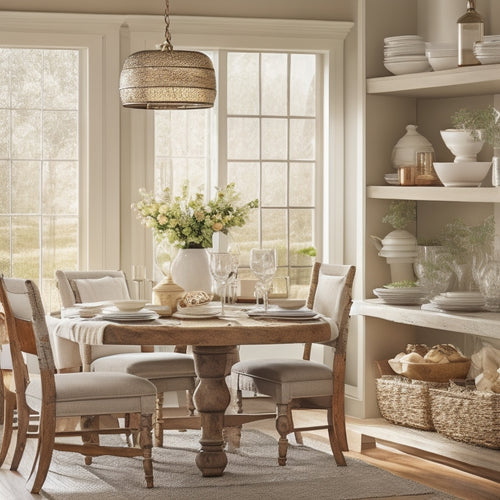
Streamline Your Recipe Binder With These Pro Tips
Share
You're tired of digging through a disorganized recipe binder, wasting time searching for favorite dishes. It's time to streamline! Start by categorizing recipes by course type, like appetizers and desserts, and use color-coded tabbed dividers to make them easy to find. Prioritize your most-used recipes, store them in protective sleeves, and keep track of their sources. By implementing these pro tips, you'll save time and reduce frustration. And, with a little more effort, you'll be able to find the recipe you need in seconds, and open up a world of new cooking possibilities waiting to be discovered.
Key Takeaways
• Organize recipes by course type, such as appetizers, soups, and desserts, to improve meal planning and organization efficiency.
• Use colorful tabbed dividers to categorize recipes visually, making it easy to locate specific dishes and manage your binder.
• Prioritize frequently used recipes by placing them at the beginning of each section, saving time and effort in meal preparation.
• Store recipes in individual protective sleeves to preserve them from damage and simplify cleanup.
• Record recipe sources alongside ingredients and instructions to give credit, track modifications, and create a personalized cookbook.
Categorize Recipes by Course Type
Categorize your recipes by course type, such as appetizers, soups, salads, entrees, sides, and desserts, to make finding a specific recipe a breeze. This simple step will revolutionize your meal planning and recipe organization.
Imagine being able to whip up a delicious dinner without rummaging through a disorganized binder or scrolling through endless digital files. By categorizing your recipes, you'll save time and reduce stress in the kitchen.
As you organize your recipes, think about the types of meals you typically serve. Do you have a lot of vegetarian options or comfort food classics? Create sections for each course type and file your recipes accordingly.
You can also consider creating subcategories within each section, such as 'quick and easy' or 'special occasions.' With your recipes neatly categorized, you'll be able to plan meals more efficiently and make the most of your recipe collection.
Plus, you'll be able to easily share recipes with friends and family or find inspiration for new dishes to try.
Color-Code With Tabbed Dividers
Take your recipe organization to the next level by introducing a colorful system of tabbed dividers that visually separate your categorized sections. This binder management technique will make it easy to locate specific recipes and add a pop of color to your binder. Assign a distinct color to each course type, such as appetizers, main courses, desserts, and so on. This visual cue will help you quickly identify the section you need.
Here's an example of how you can color-code your tabbed dividers:
| Course Type | Color |
|---|---|
| Appetizers | Red |
| Main Courses | Blue |
| Desserts | Yellow |
| Beverages | Green |
| Snacks | Orange |
Prioritize Most-Used Recipes First
By positioning your beloved and frequently utilized recipes at the beginning of each segment, you'll save time and effort when organizing meals. This simple tip guarantees that your preferred dishes are readily available, simplifying meal preparation.
Categorize by frequency, grouping recipes into sections like 'weekday essentials' or 'special event highlights.' This method allows you to swiftly locate the recipes you frequently utilize.
Tailor by event to elevate your organization. Establish distinct segments for festive occasions, birthdays, or other noteworthy gatherings. This approach will assist in menu planning and maximizing your recipe assortment. For example, if you have a preferred Christmas cookie recipe, place it in a 'Holiday Baking' category.
Store Recipes in Protective Sleeves
To shield your prized recipes from kitchen chaos and spills, slip each printed or handwritten page into individual protective sleeves. This simple step will preserve your recipes for years to come, keeping them clean, dry, and intact.
You'll be able to focus on cooking inspiration, rather than worrying about recipe preservation.
Here are three benefits of storing recipes in protective sleeves:
-
Easy cleanup: If a spill occurs, the sleeve will contain the mess, making cleanup a breeze.
-
Recipe longevity: Protective sleeves will prevent tears, stains, and fading, ensuring your recipes remain legible and usable.
-
Organization made easy: With each recipe safely stored in its own sleeve, you can easily flip through your binder and find the recipe you need, maintaining a sense of kitchen organization.
Keep Track of Recipe Sources
Your recipe binder becomes a valuable resource when you can remember the inspiration behind each dish, so jot down the source of each recipe alongside the ingredients and instructions. This way, you can give credit where it's deserved and revisit the original recipe if necessary.
Organize your sources by website, cookbook, or author to make it easy to reference later. For online recipes, note the website's URL or the date you accessed it. For cookbooks, write down the title, author, and page number.
As you make a recipe, track any modifications you make, no matter how small. Did you substitute an ingredient or add a new spice? Jot it down. This will help you refine the recipe to your taste and maintain consistency.
You can also use this information to create your own variations or share your adapted recipe with others. By keeping track of your recipe sources and modifications, you'll create a personalized cookbook that's tailored to your cooking style and preferences.
This attention to detail will make your recipe binder a cherished resource for years to come.
Use a Consistent Filing System
With your recipe sources and modifications accounted for, you'll want to organize them in a way that makes sense, so it's time to develop a consistent filing system that works for you. This will make sure that you can easily find the recipe you need when you need it.
To achieve this, consider the following strategies:
-
Alphabetical Organization: Organize your recipes in alphabetical order by dish name or main ingredient. This makes it easy to locate a specific recipe and guarantees your binder remains tidy.
-
Labeling Categories: Create categories such as 'Breakfast,' 'Desserts,' or 'Vegetarian' and label them clearly. This allows you to group similar recipes together, making it simpler to find what you're looking for.
-
Recipe Index: Create an index at the beginning of your binder that lists all your recipes in alphabetical order. This serves as a quick reference guide, saving you time and effort when searching for a particular recipe.
Digitize Handwritten Recipe Cards
Now that you've organized your recipe sources, it's time to tackle those handwritten recipe cards that are cluttering up your kitchen drawers and digitize them for easy access. By digitizing your handwritten recipe cards, you'll be able to free up physical storage space and have a backup of your favorite recipes in case the originals get lost or damaged.
Here are some steps to help you digitize your handwritten recipe cards:
| Step | Task | Tools Needed |
|---|---|---|
| 1 | Take a clear photo of each recipe card | Smartphone or camera |
| 2 | Edit the photo to enhance readability | Photo editing app or software |
| 3 | Save the edited photo to a digital folder | Cloud storage or computer |
| 4 | Create a digital index of your recipes | Spreadsheet or note-taking app |
Frequently Asked Questions
Can I Use a Binder With a Lock to Secure My Recipes?
You're considering a binder with a lock to secure your recipes, which is a great idea for protecting your culinary secrets! However, you might also want to explore digital recipe storage or eco-friendly alternatives for a more sustainable recipe organization approach.
How Do I Handle Recipes With Multiple Cooking Methods?
Like a conductor leading an orchestra, you'll harmonize multiple cooking methods by creating separate recipe cards for each method, using different size cards to differentiate, and storing them digitally or physically in a categorized system for easy access.
Are There Any Eco-Friendly Binder and Sleeve Options Available?
You'll find eco-friendly binder and sleeve options made from sustainable materials, ensuring organization and durability. Look for recycled paper products, biodegradable sleeves, and reusable binders that reduce waste, aligning with your values of serving others and the planet.
Can I Customize My Binder With Personal Photos or Artwork?
You can definitely add a personal touch to your binder by incorporating photos or artwork that inspire your cooking style, making it a unique reflection of your creative organization and personalized customization.
Are There Any Specific Binders Designed for Left-Handed Users?
"Cut to the chase, you're probably wondering if left-handed users have binders tailored to their needs. Rest assured, you'll find binders designed with left-handed organization in mind, often featuring reversed layouts and enhanced binder security for ease of use."
Related Posts
-

Sink Caddy Organizers for Farmhouse Style Kitchens
Sink caddy organizers are perfect for elevating your farmhouse-style kitchen while keeping it functional. You'll love...
-

Spice Rack With Integrated Herb Garden
A spice rack with an integrated herb garden alters your kitchen into a culinary haven. You'll have fresh herbs at you...
-

Corner Cabinet Storage for Dinnerware Sets
Corner cabinet storage for dinnerware sets can change your kitchen into an organized, stylish space. By utilizing ver...


